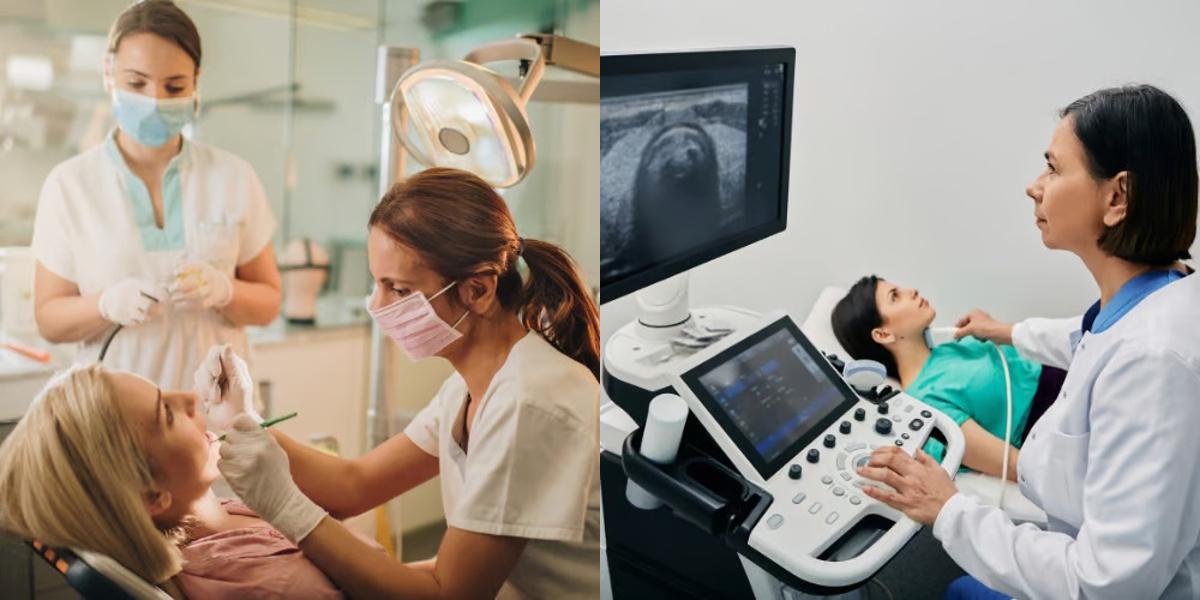Dental Assistant vs Diagnostic Medical Sonographer

Key Points:
- Dental Assistants provide support to dentists; Diagnostic Medical Sonographers operate imaging equipment to produce images for medical diagnosis.
- Dental Assistants typically earn less than Diagnostic Medical Sonographers.
- Both fields have good job prospects.
- Dental Assistants can often receive on-the-job training or complete a short vocational program, while Diagnostic Medical Sonographers require a 2-year associate's degree or a 4-year bachelor's degree.
- Dental Assistant training is generally more affordable and shorter in duration compared to Diagnostic Medical Sonographer programs.
The healthcare industry is constantly growing, and with that growth comes a demand for skilled professionals in various roles. Dental assistants and diagnostic medical sonographers are two such professionals who play vital roles in patient care. Both professions require a strong attention to detail, excellent communication skills, and a passion for helping others. However, the specific job responsibilities and required training for each profession differ significantly.
Dental Assistant vs Diagnostic Medical Sonographer: Career Outlook and Salary
Dental Assistant Career Outlook and Salary: According to the Bureau of Labor Statistics (BLS), the employment of dental assistants is projected to grow 7 percent from 2019 to 2029, faster than the average for all occupations. This growth is due to ongoing research linking oral health to overall health, increasing the demand for preventative dental services. As of May 2020, the median annual wage for dental assistants was $41,180.
Diagnostic Medical Sonographer Career Outlook and Salary: The BLS projects that the employment of diagnostic medical sonographers will grow 17 percent from 2019 to 2029, much faster than the average for all occupations. This growth is attributed to the increasing use of ultrasound imaging as a safer alternative to other imaging techniques. As of May 2020, the median annual wage for diagnostic medical sonographers was $75,920.
Final Thoughts
Choosing a career in the healthcare field is an excellent decision, as it offers stability, growth opportunities, and the chance to make a positive impact on people's lives. Both dental assisting and diagnostic medical sonography are rewarding professions that require a dedication to patient care and a commitment to ongoing learning.
Ultimately, the choice between becoming a dental assistant or a diagnostic medical sonographer depends on your interests, strengths, and long-term career goals. Consider factors such as the type of work environment you prefer, the level of patient interaction you desire, and the amount of time you are willing to invest in education and training.
Regardless of which path you choose, both dental assistants and diagnostic medical sonographers play crucial roles in the healthcare system and are valued members of the healthcare team.
Dreambound's programs are available in different locations. Explore the following blogs for comprehensive details on these two vocations, including their requirements and guidelines on joining:

Winlynd Caballero is a member of Dreambound's Sales team. She helps in handling the company's finullcial transactions, generating reports, and school sales. Beyond her responsibilities in the realm of numbers and business, Winlynd finds herself deeply immersed in a world of art and music.




